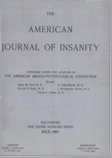ON THE ETIOLOGY AND THE PREVENTION OF MONGOLISM
Abstract
(1) It is our opinion that mongolism is not due to hereditary factors. If it were due to these factors, the incidence of mongolism should increase in proportion to the number of offspring according to Mendelian expectation. Although many mongoloid children have 5 to 12 siblings, no multiple incidence of mongolism is found in any of these families. Mental deficiency in a family is no protection against mongolism, but the coincidence does not explain the particular growth disorder of the mongoloid child.
(2) The theory based mainly on twin research, that mongolism is due to a germinal (plasmatic) disorder does not hold. It is demonstrated that the observations on mongoloid twins are open to various interpretations.
(3) The third theory to explain the occurrence of mongolism is that of a pathologic condition of the mother. The method of analysis which we adopted brings in our opinion conclusive evidence that the maternal condition at the time of pregnancy was at fault
(4) A study of the birth order of mentally deficient children due to germinal factors shows that the birth of a defective child may be expected to occur at any place in the line of siblings. In an unbiased sample of families in which all children are analyzed, as many children are born before the individual with a given characteristic as after the affected individual. In some families, the affected child may be born first, in other families last. These differences cancel each other in the long run, and a balance of siblings born before and after the affected child is demonstrable. This point is proven by two lines of control studies; one is made on a material of 4,316 mentally defective children of all types and the other on a material of 255 hereditary cases at the Wrentham State School. In both independent studies, the result was that mental defect as a characteristic is not associated with any particular disturbance of the birth order. In an ideal sample, 50 per cent of brothers and sisters would be born before and 50 per cent born after the affected child. In our material 48 per cent were born before and 52 per cent afterwards in one line of studies and 54 per cent were born before and 46 per cent subsequently in the other investigation. This represents a variation which is well within expectation and offers proof of the theoretical assumption.
(5) In a study of the birth order of mongoloid patients, the striking result was found that 84 per cent of the total number of brothers and sisters was born before the mongoloid and only 16 per cent afterwards. Comparison with the control group shows that this is a significant deviation.
(6) The imbalance between the number of children born before and after a mongoloid suggests that the birth of a mongoloid indicates the development of a pathologic condition of the mother and bears a definite relationship to her ability to have children.
(7) It is indicated that the decline in the number of children after a mongoloid birth cannot be explained on psychological grounds.
(8) Mongolism occurs mainly under three conditions: (1) at the end of the childbearing period, when the mother is approaching the menopause; (2) at the beginning of childbearing, when the mother is immature or when the first child is born after a long period of waiting and the mother shows a delayed adaptability to the condition of pregnancy; (3) in the middle of the childbearing period due to intercurrent extrinsic factors.
(9) The common denominator for the condition, under which mongolism develops is the threshold of sterility. The sterility is caused by a hormonal imbalance which manifests itself in abortions, bleedings during pregnancy, prematurity and incapacity for conception. The mongoloid deficiency develops in a baby on the threshold of complete maternal sterility. Our material indicates that the maternal innersecretory response to a pregnancy is at fault.
(10) A careful inquiry into the birth records of mongoloid children reveals that the birth of a mongoloid child may be expected or even predicted in a certain percentage of cases. From a medical point of view, many mothers of mongoloids show indications that they were not in a perfect condition for pregnancy. It is our suggestion that pregnant women whose history indicates the possibility of a mongoloid baby should be subjected to careful biochemical and endocrine studies during prenatal care. Such examination will provide material to determine whether a mother suffers from an endocrine deficiency and will enable the physician to single out eventually a mongoloid pregnancy. This approach might not secure every case of this disorder, but might serve to reduce the number of mongoloids to a reasonable extent.
Access content
To read the fulltext, please use one of the options below to sign in or purchase access.- Personal login
- Institutional Login
- Sign in via OpenAthens
- Register for access
-
Please login/register if you wish to pair your device and check access availability.
Not a subscriber?
PsychiatryOnline subscription options offer access to the DSM-5 library, books, journals, CME, and patient resources. This all-in-one virtual library provides psychiatrists and mental health professionals with key resources for diagnosis, treatment, research, and professional development.
Need more help? PsychiatryOnline Customer Service may be reached by emailing [email protected] or by calling 800-368-5777 (in the U.S.) or 703-907-7322 (outside the U.S.).



